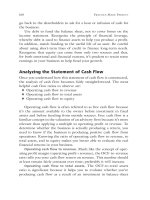Tài liệu Practice Made Perfect 13 pptx
Bạn đang xem bản rút gọn của tài liệu. Xem và tải ngay bản đầy đủ của tài liệu tại đây (107.2 KB, 10 trang )
98 PRACTICE MADE PERFECT
pensation was a factor in their deciding to leave, though the typical
adviser believes money is the only reason people leave their firm.
When you consider that the primary reasons to hire staff in the
first place is to create better leverage and delegate the work you’re
not particularly skilled at or interested in, then employee perceptions
about lack of challenge are especially jarring. Firms that have high
retention rates among valued employees do several things well:
! They have a management team that is aligned and cohesive and
has a shared focus.
! They have the right people in the right jobs.
! They maximize leadership strengths and focus resources on stra-
tegic priorities.
! They have an organizational structure that’s efficient, produc-
tive, and leverageable, while enhancing growth and supporting
current business operations.
! They link business goals to position responsibilities, perfor-
mance metrics, and reward systems.
! They emphasize teamwork, accountability, and commonality.
! They attract, retain, develop, and reward talents.
! They celebrate successes.
Managing Culture
Organizational culture is one of those soft and squishy concepts that
make financial-advisers-turned-business-managers queasy. It’s also
one of the primary drivers of staff satisfaction and staff turnover. It
boils down to answering the question, “What’s it like to work here?”
When it’s working well, the culture is the key element that holds the
organization together, gives everyone a common identity, and drives
commitment and behavior.
The keys to managing culture are:
! Knowing what the current culture is—getting feedback
! Knowing what the future culture should be
! Clearly defining and communicating both
! Being prepared to commit to a lengthy process of change
! Tying all factors and functions together
! Continually monitoring
! Ensuring that change is valued
THE CARE AND PREENING OF STAFF: PROFESSIONAL DEVELOPMENT 99
Managing Difficult People
The downside of growing your business is that you have more people
to manage. Some financial advisers are predisposed to this role and are
able to follow their instincts; others are not. But we do not know of a
single business owner who hasn’t struggled with the question, “Am I
managing difficult people, or do I have difficulty managing people?”
One of the challenges for advisers is the idea that everyone they
employ is a friend or a member of the family. As a consequence, the
practice drifts and the owner suffers in silence. We know of multiple
situations in which the firm has made a modest profit for years, and
the owner has taken out no salary or no more than a meager draw
for many months. In many of these situations, the staff is paid more
than the owner.
Why does this occur? The most common refrains we hear from
the owners are, “No one is accountable here!” and “There are no
consequences if they don’t perform.” That’s when we grab the own-
ers by the lapel, shake them hard, look them in the eye, and tell
them, “You’re the boss! You hold your staff accountable.” And if
your so-called friends—the people in your organization whom you
cannot confront—fail to fulfill what is expected of them, then they
obviously don’t regard this friendship as highly as you do. Oddly
enough, the same people are likely to be annoyed with you because
you’re not setting boundaries and holding them accountable.
An article in a parenting magazine not long ago noted how each
successive generation of parents has become more permissive in rear-
ing its children. It observed that our contemporaries—especially those
raised in more authoritarian households—desire to be friends first,
parents second. They proudly boast about this warm and fuzzy qual-
ity that had been absent in their own childhood even as they whined
about how incorrigible their kids have become. Many advisers apply
this same theory to managing and leading their staff. In an ideal
world, you would have created a workplace in which motivated people
can manage themselves, but the reality is that most employees need
some structure, focus, and reinforcement at least some of the time.
Of course, advisers often want to keep their business small to avoid
bureaucracy. But many think this means they can also avoid conflict
with their staff. That’s not possible. Having structure doesn’t mean
100 PRACTICE MADE PERFECT
you can’t have a happy, fun, cheerful, and even loose environment.
It does mean that an absence of processes, protocols, measurements,
and evaluations will lead to dysfunction.
If you have ever worked for somebody else, you should ask
yourself the question, “Have I ever been mismanaged?” There’s a
high probability your answer will be yes. Somewhere in your career,
you’ve probably worked for someone who did not appreciate you,
respect you, or pay you appropriately. Assuming your perception
about that experience is correct, have you ever thought about how
you lead your own people and do you apply the management lessons
you learned from that personal experience? Like parents, we often
apply approaches we were conditioned to learn, which causes those
we’re supervising to rebel.
It can also be useful—as you recall what it was like to work
for someone else—to reflect on the conversations you had with
coworkers. Think about the after-work pub crawls, where your
antipathy toward your employer grew increasingly passionate in
proportion to the pints consumed. Or how about the times you
challenged your bosses and threatened to quit? In hindsight, how
much of your complaint was valid, and how much of your rage was
a result of your own insecurity? That’s not to say your frustration
was unjustified, but immaturity may have pushed your reaction out
of proportion, and your attitude may have portrayed you as “not a
team player.”
The recognition of what’s troubling your staff and how you’re
relating to them may help you to deal with those employees you
regard as “difficult.” But before you decide this is just another out-
of-touch consultant who blames the parent or the boss, it’s not
impossible that you may indeed have a jerk or two working for you,
and there may be nothing you can do about them except to kick
them out.
In our consulting with financial-services firms on organizational,
staffing, and strategic issues, we must delve into the human dynamics
of the business. We find some common reasons for discontent that
can usually be solved by getting the strategy and the structure back
into alignment and by helping the businesses to improve internal
communication. In many other cases, we find that clearly defining
THE CARE AND PREENING OF STAFF: PROFESSIONAL DEVELOPMENT 101
a career path goes a long way toward getting people to focus on
a goal instead of on their navel. Nevertheless, there may very well
be an employee or a partner who single-handedly sucks the energy
and enthusiasm right out of the practice. Such people are not happy
unless they’re unhappy. They’re carriers of a potentially virulent dis-
ease we call “staff rot.”
Taking Action
Your obligation as a manager is to assess whether the person is a
chronic problem or whether the attitude is justified and fixable.
It’s difficult to differentiate between the two, although it’s often
worth the effort. People who challenge you can often be intelli-
gent, driven, and dynamic individuals whose energy and creativity
you’d do well to harness to help propel your business forward. In
many cases, they can be tremendous revenue producers, so the dol-
lars blind our judgment.
But if advisers were to look back at their biggest management
mistakes, they would probably admit that they did not deal with
these types of people quickly enough. And by people, we mean both
partners and staff. Such individuals have the uncanny ability to make
you feel like their problems are your fault. Our tendency is to show
them love, accommodate them, acknowledge their pain, and throw
money at them in the hope that we can be redeemed in their eyes.
But appeasement does not usually work for the long term when
you’re dealing with people who are immature and insecure. What ails
them is a moving target. The problem is especially unsolvable if they
cannot tell you specifically what it would reasonably take for them
to feel fulfilled in your business. But at what point does it become
necessary to confront them? If they suffer in silence, or triangulate
the complaint by venting to people other than you, your situation is
close to hopeless, so it’s time to act.
It’s estimated—in The War for Talent (Harvard Business School
Press, 2001)—that about 15 percent of the workforce within any
company is nonperforming (not meeting critical success initiatives).
Imagine what you could do with 15 percent of the payroll. The
chance to add 15 percent to the bottom line and reinvest or redirect
it to top performers is certainly worth your attention.
102 PRACTICE MADE PERFECT
We have helped many firms to reconfigure their human-capital
equation through the strategy of the five Bs: buy, build, borrow,
bounce, and bind. We use a series of tools such as Profile™ or
Kolbe™ benchmarking, interviewing, organizational surveying and
auditing, and plan redesign to help our clients reconfigure their
human capital to maximize results and profits. There are several
steps you can take now.
First, if you do not have a formal evaluation process, you must
implement one, as described earlier in this chapter. Formal appraisals
give you a foundation for counseling the staff member.
There is a practical model for resolving differences among people
and helping steer behavior either to exceptional performance or out
the door. We call that process the DESCO model, and it works best
when the following five steps are deployed:
1.
Describe the specific observed behavior that you want to dis-
cuss.
2.
Express your feelings, reactions, and concerns about the behav-
ior.
3.
Suggest an alternative behavior or set of behaviors.
4.
Consequences (state them).
5.
Offer support to help the person “move up or move out.”
Second, you must listen and respond to the employee, not react.
If the employee’s point is valid, you should obviously acknowledge
it and deal with it. If you don’t feel you can be responsive to the
complaint, then you must be forthright about the reason why. If the
problem is a perpetual thorn in the employee’s paw, then explore
whether there is another solution. If it’s a nuisance issue, you can
deal with it. But if the problem is too great for either of you to over-
come and it’s affecting morale, then encourage the employee to seek
work elsewhere. But be sure you understand whether he or she is the
problem or you are.
One employee of an advisory firm, for example, felt that the
owner had encouraged him to do something unethical. This event
had occurred a couple of years earlier, and it was difficult to confirm
whether it occurred the way the employee recalled it—the commu-
nication between the two was loose and subject to interpretation.
THE CARE AND PREENING OF STAFF: PROFESSIONAL DEVELOPMENT 103
But no such request was ever made again by the owner. Nonetheless,
for the next two years, whenever there was conflict or this employee
became overwhelmed with work, he would bring up the issue, always
concluding with, “And this is why I’m not sure I can keep working
here.” Situations like this become a distraction and manipulative.
Whether or not the complaint is valid, if such an affront could not
be buried after two years, it’s unlikely it will ever be resolved. Yet
the issue defined the relationship between employee and employer
and caused the boss to look for ways to appease this person through
money, extra attention, time off, a new title, and so on. Obviously,
this employee had found the right button to push, and the boss’s
reactions encouraged him to continue with this strategy of torment
and guilt.
Third, consider using the psychometric tests described previously,
such as Profile™ or Kolbe™, to determine whether the individual
is truly suitable for the job. We always encourage such assessments
be applied in the hiring process because they provide tremendous
insight into whether individuals have the motivation, personality,
interests, and ability to perform certain work. We also find them to
be a powerful means of understanding what makes people tick. Bad
behavior can be triggered by boredom or frustration. For example,
your employee may have been hired for a highly technical position
and was judged qualified by his experiences, background, and edu-
cation. But if his mind map indicates that he cannot sustain a long-
term interest in such detailed or complex work, then he’ll burn out
like a supernova. He himself may recognize he’s no longer able to
fulfill your expectations. Rather than owning up to this, he will lash
out at you as the reason he’s foundering.
As with parenting, there isn’t much practical training available
for bosses until they’re on the job and in the line of fire. But good
advisers tend to be intuitive people, so applying these techniques
to the staff may help you get to the root cause of the issue. That
said, do not overindulge those who will not conform to the cul-
ture you’re trying to build. Ultimately, it’s up to employees to act
their age. If they’re unable to respond positively to constructive
solutions that are within the framework of your business purpose
and expectations, it may be best to cut your losses and find people
104 PRACTICE MADE PERFECT
who will. As Winston Churchill said, “Graveyards are filled with
indispensable people.”
Hiring Your Boss: Do You Need a CEO?
Does your advisory practice need a chief executive officer? As the
financial-advisory profession evolves from offering well-paying jobs
to providing real career paths, more and more growing practices are
concluding that they do. In the 2003 Compensation and Staffing
Survey conducted by Moss Adams for the Financial Planning
Association, we found that 52 percent of firms that generate more
than $1 million in annual revenues employ the services of a CEO.
Clearly, every growing business needs a leader who will provide
strategy and planning and who has executive management skills to
translate that vision into action—whether or not that person is a
professional CEO.
Unfortunately, most financial advisers have little or no training
or background in business management, so they’re forced to hire
from the outside. But practitioners who do hire a CEO are often
disappointed with their hiring decisions. It’s difficult for most own-
ers of advisory firms to give up the strategic leadership role in their
business. That’s why firms rarely succeed when they hire a full-time
CEO who has no role in client service or development. It’s virtually
impossible emotionally for advisers to surrender the responsibilities
of leading the firm.
However, professional management is important whether it’s
the responsibility of the owners themselves or of outside hires.
Depending on the size of the firm, the position could be a general
manager or a chief operating officer (COO). As chairman and CEO
of the practice, the individual reports to the owner, who most likely
is the founder or one of the lead advisers. The general manager’s role
is to be accountable for implementation of financial management,
operations, information technology, and human-capital strategies
within the firm. Occasionally, depending on the size of the firm,
he or she may also be responsible for sales and marketing. The key
concept is that the manager makes sure the infrastructure of the firm
is operating efficiently, effectively, and productively.
THE CARE AND PREENING OF STAFF: PROFESSIONAL DEVELOPMENT 105
So why do so many advisers who hire CEOs end up disappointed?
In consulting with many such firms about their organization and
compensation plans after they’ve become disillusioned with the
experience, we’ve discovered some common complaints about the
CEOs they’ve hired:
! It costs too much for management; I could do what he (she)
does.
! We’re paying too much for what we get.
! She’s trying to create a strategy that I’m not comfortable
with.
! He’s making decisions unilaterally.
! She will not handle details.
! He will not address the big strategic questions.
! She has poor people skills.
! We cannot get the reports we want and need.
! He has no sense of urgency or priority.
! Her answer for everything is to hire more staff.
! He cannot deal with conflict or difficult situations.
! She wants to renegotiate her contract.
! He says we are not clear in what we want from him.
Common Mistakes in Hiring a CEO
Although some of these observations are likely true, the core of
the problem is a hiring issue. Too often, the person hired for this
role was chosen based on the impressiveness of the résumé and
(especially) big-company experience rather than on any specific
qualifications to run a small, financial-services business. And often
the cost of hiring such a person is out of proportion to the size
and complexity of the business, which puts added strain on the
relationship. More often than not, the owners of the practice can-
not comfortably delegate the responsibilities they should to a CEO,
who is responsible for bringing the business to the next level. Is it
any wonder that these CEOs do not fulfill the expectations of the
owners who hired them?
What follows are the most common mistakes we see advisers
make in hiring professional management.
106 PRACTICE MADE PERFECT
Failure to clearly define the roles and expectations of the indi-
vidual CEO.
Most financial-advisory practices are small businesses—
certainly too small to be consumed by titles and size of offices. Yet
the common misperception is that a firm needs to have a bona fide
CEO at the helm before it can be regarded as a business. In their
book Navigating Change: How CEOs, Top Teams, and Boards Steer
Transformation (Harvard Business School Press, 1998), Donald
Hambrick, David Nadler, and Michael Tushman suggest that the
role of a CEO falls into three broad categories:
1. Envisioning. Successful CEOs share an ability to articulate
and communicate a vision of the organization that captures
the imagination of the people they lead.
2. Energizing. Effective CEOs energize their people by continu-
ally and publicly demonstrating their own sense of personal
excitement and total engagement. They consistently convey a
sense of absolute confidence in the organization’s ability to
achieve the most challenging goals.
3. Enabling. Effective CEOs find realistic ways to give people the
confidence, authority, and resources they need to work toward
their shared objectives.
If you examine these roles, you begin to realize that either these
are the functions you personally are supposed to perform as the
leader of the business, or you have to have the self-confidence to
vest your new leader with this authority. More important, you have
to decide if what you’re looking for is truly a CEO or just a general
manager to perform the management and personnel tasks that you
would rather not do.
Failure to link the hiring of a CEO to a business strategy. Every
practice-management decision should be tied into your business
strategy. For example, if your vision is to grow your practice to
three times its current size in the next five years, you’ll want to
recruit leaders who have experience with rapidly growing businesses.
On the other hand, if you want to build a dominant regional
firm, you might do better with someone well versed in your local
market or skilled at acquiring and consolidating smaller indepen-
THE CARE AND PREENING OF STAFF: PROFESSIONAL DEVELOPMENT 107
dent businesses. Furthermore, you want to reward those leaders
for helping you achieve certain benchmarks in your growth. If you
do not have clarity of vision, you may as well be operating in the
dark. The consequence will be multiple false starts and thousands
of wasted dollars.
Many hires within financial-advisory practices occur because the
owner stumbles on somebody who has become available. This mis-
take happens with all positions. Rather than thinking about what
the organization should look like to better achieve its goals, owners
react to perceived opportunities because the résumé is so impressive.
Indeed, advisers often exhibit a bias toward hiring based on seductive
résumés touting advanced degrees and big-company experience. The
process should be more deliberate:
! What are the responsibilities that I want to delegate?
! Where are the leadership gaps that are impeding the firm’s
progress?
! What level of revenue must I generate to support this position?
! How will I know I’ve hired the right person, or how will I know
if I’ve hired the wrong person?
! What characteristics must the person have to improve my
practice?
! What job experiences or education does the candidate need for
this role?
With this framework, practitioners can be more thoughtful about
the position they’re trying to fill and what their expectations are.
Failure to interview properly. It’s essential to probe for real
insight into an individual’s makeup, aptitude, motivation, interests,
and personality. Literally hundreds of psychometric tools are avail-
able that serve as useful sources of insight and information into how
individuals are likely to perform their jobs.
It’s not as important to hire the most intelligent people as it
is to hire folks who have an aptitude or ability to quickly learn in
the areas in which you want them to be strong. In particular, you
need to evaluate their general abilities as well as their ability to
work with numbers, words, or concepts. One of these may be more









